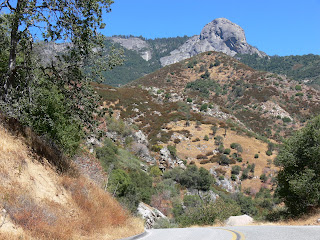 The view of the Sierra Mountains from the valley below.
The view of the Sierra Mountains from the valley below. Driving in the Sequoia National Park.
Driving in the Sequoia National Park. Moro Rock, 6,725 ft.
Moro Rock, 6,725 ft. View of Moro Rock from the other side.
View of Moro Rock from the other side. Climbing to the very top.
Climbing to the very top. Almost there...
Almost there... Birds' eye view...
Birds' eye view... Isn't it simply breathtaking?..
Isn't it simply breathtaking?.. View of the mountains from the top.
View of the mountains from the top. Giant Sequoia Grove.
Giant Sequoia Grove. Mirek and one of the sequoias.
Mirek and one of the sequoias. Feeling rather small ..., but happy.
Feeling rather small ..., but happy. Hollow tree trunk.
Hollow tree trunk. Sequoia cones are the size of a chicken egg.
Sequoia cones are the size of a chicken egg. Sequoia seeds are the size of an oat flake.
Sequoia seeds are the size of an oat flake. Controlled burning in the park.
Controlled burning in the park. We barely made it through!
We barely made it through!Giant Sequoia Ecology (from National Park Service brochure):
"Sequoias don't die of old age and are resistant to fire and insect damage. Most die by falling over. These huge trees sprout from seeds as small and as light as oat flakes. Mature trees may yearly produce 2,000 egg-size cones-bearing 400,000 seeds dispersed only as cones open. Cones hang on the trees, green and closed up to 20 years. Douglas squirrel or larvae of a cone-boring beetle may make few cones open, but fire is the key to seed dispersal and seedbed fertility. It makes the cones dry, open, and drop seeds. It lets sunlight in and burns logs and branches on the forest floor to ashes as fertilizer."
We will be talking about our visit to Sequoia National Park for years to come. That day we not only had a fantastic time exploring the park, climbed the giant rock and enjoyed the views, but also learnt a lot about the life of one of the most amazing living things on Earth. The trees that remember Jesus...

0 comments:
Post a Comment